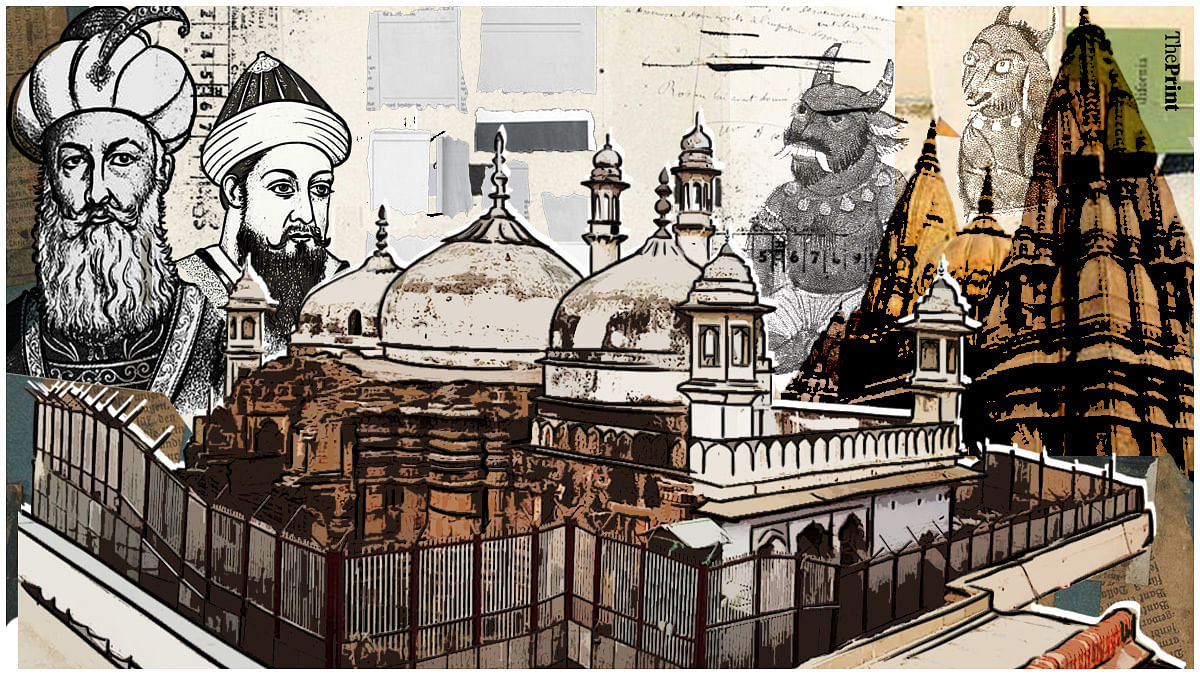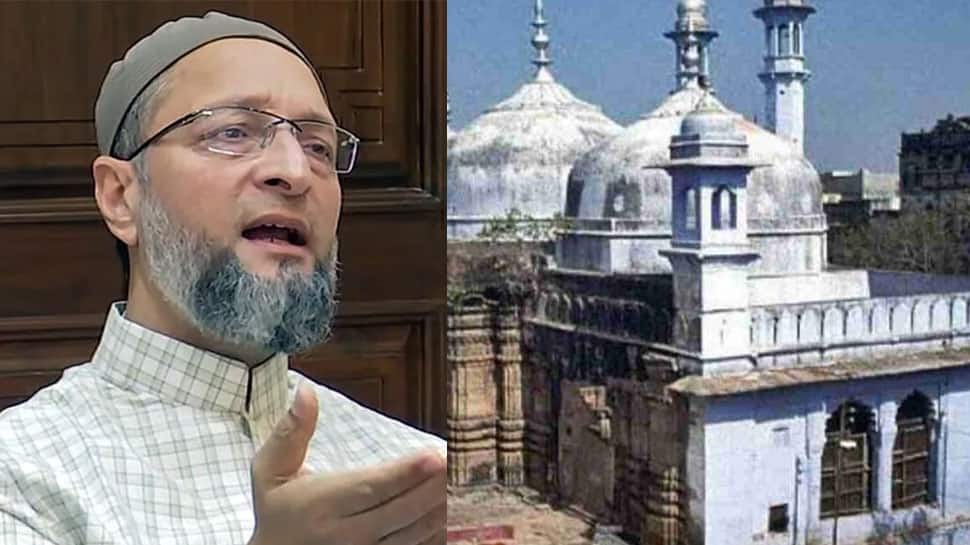S
Shruti Dasgupta
Guest
Kashi’s history stretches back to at least 3500 years. As a sacred city that predates Western civilizations like Athens, Rome, and Egypt; the Kashi finds mention in Skanda Purana, Adi Shankarachrya’s Kasi Panchakam, and other Hindu religious texts. Even Persian texts like Ain-i-Akbari and Mughal travelogs like Al-Biruni tell tales of this holy city and its Kashi Vishwanath Temple.
The latest report by the ASI has the AIMIM and other Muslim organizations in a panic. The report conclusively states that the much-debated Masjid stands on top of a pre-existing mandir. Additionally, it states that the Masjid Structure uses remnants of the ealier mandir in its contructions. The West wall is the most complete remamnt of the erstwhile mandir. This conclusion by ASI gives Sanatana Bharat new hope. With Kaal Bhairav as the guardian deity of Kashi, it seems that the Kashi Vishwanath Temple is ready to be restored.
One of the 12 Jyotirlingas is situated at the Kashi Vishwanath Temple. The existing quadrangle and its temple struture, beside the original mandir, was rebuilt in 1780 CE by the Malwa Queen, Rani Ahilya Bai Holkar. The gold dome, that crowns the mandir, was Maharaja Ranjeet Singh’s gift to the temple.
However, this temple was made later by Hindu monarchs. Its purpose was to give Hindus a temporary place of worship. It does not replace the original milleni-old sacred mandir that is mentioned in several historical and religious texts.

PC YouTube @SunilKumarTelugu

PC The Print
The journey of Gyanvapi Kashi Vishwanath Temple is a saga of destruction and reconstruction. It also symbolizes the resilient struggle that Hindus have gone through to keep their faith alive. Despite repeated invasions and demolitions, the spirit of devotion still prevails. The temple that stands today is a testament to the unwavering faith of a billion Sanatanis.
Hindus have consistently sought justice through legal means to rebuild the original temple. During the British colonial era, the demand for justice continued as Hindus fervently appealed to the British authorities. However, like that of Ayodhya’s Ram Mandir, the cries for restoration of a Hindu sacred site went unanswered.
The Gyanvapi Mandir’s struggle for the preservation of cultural heritage and religious sanctity echoes through generations. The legal battle to reclaim Sanatni heritage continues to date. Recently, the ASI’s conclusive report states that the much-debated Masjid Structure was built on top of a Hindu temple. All hell is about to break loose in Bharat due to this report.
Irfan Habib, a leftist pseudo-scholar, states that one cannot demolish a 16th-century structure today! However, he feels no objections to the topic of the Islamic destruction of a millennia-old Mandir!

PC India Today

PC Zee News – India.com

PC OpIndia
While the legal battles will run wild and long, Hindu patience is Sanatna in nature. We shall not let illogical objections and laws stand in our way of reclaiming our mandirs.
Bharat’s truth shall undergo any Agni-Pariksha set before it by Islamists and apologists! The facts do not lie! Let Varanasi’s Disputed Structure rename itself to Kashi’s Gyanvapi Mandir! Har Har Mahadeva!
The post Gyanvapi Mandir: A Saga of Faith, Destruction, and Reconstruction appeared first on The Jaipur Dialogues.
Continue reading...
The latest report by the ASI has the AIMIM and other Muslim organizations in a panic. The report conclusively states that the much-debated Masjid stands on top of a pre-existing mandir. Additionally, it states that the Masjid Structure uses remnants of the ealier mandir in its contructions. The West wall is the most complete remamnt of the erstwhile mandir. This conclusion by ASI gives Sanatana Bharat new hope. With Kaal Bhairav as the guardian deity of Kashi, it seems that the Kashi Vishwanath Temple is ready to be restored.
Historical Evidence of Gyanvapi Kashi Vishwanath Mandir
One of the 12 Jyotirlingas is situated at the Kashi Vishwanath Temple. The existing quadrangle and its temple struture, beside the original mandir, was rebuilt in 1780 CE by the Malwa Queen, Rani Ahilya Bai Holkar. The gold dome, that crowns the mandir, was Maharaja Ranjeet Singh’s gift to the temple.
However, this temple was made later by Hindu monarchs. Its purpose was to give Hindus a temporary place of worship. It does not replace the original milleni-old sacred mandir that is mentioned in several historical and religious texts.
Ancient historical references of Gyanvapi Mandir are as follows:
- The temple finds mention in the Vedas and Skanda Purana. The Kashi Khanda, the fourth segment of the Purana, praises Lord Shiva in 11,000 verses. https://www.wisdomlib.org/hinduism/book/the-skanda-purana/d/doc423734.html
- Some historical records point to the construction of the Kashi Vishwanath Temple around 500 CE by Gupta King Vainyagupta. This puts the Gyanvapi Mandir Structure to be 2500 years old. https://www.degruyter.com/database/URBREL/entry/urbrel.11276431/html?lang=en
- Archaeological excavations at Varanasi unearthed an Avimukteshwar Seal dating back to 1000 BCE. This puts the original Kashi Vishwanath Temple Structure to be at least 3000 years old.

PC YouTube @SunilKumarTelugu
The repeated saga of destruction at Kashi Vishwanath Temple is as follows:
- The first known destruction of the temple was during the invasion of Qutub ud din Aibak in 1194 CE. It was rebuilt by a Gujarat-based merchant 50 years later.
- In 1450 CE, the temple endured another episode of destruction under Ibrahim Lodhi’s reign. Nearly 100 years later, Raja Todar Mal rebuilt the temple.
- Finally, in 1669 CE, Aurangzeb‘s commander Mir Baqi demolished the Gyanvapi Mandir to establish a mosque. This desecration of the Kashi Vishwanath Temple stands to date.

PC The Print
A Long Legal Journey Ahead: Gyanvapi Mandir
The journey of Gyanvapi Kashi Vishwanath Temple is a saga of destruction and reconstruction. It also symbolizes the resilient struggle that Hindus have gone through to keep their faith alive. Despite repeated invasions and demolitions, the spirit of devotion still prevails. The temple that stands today is a testament to the unwavering faith of a billion Sanatanis.
Hindus have consistently sought justice through legal means to rebuild the original temple. During the British colonial era, the demand for justice continued as Hindus fervently appealed to the British authorities. However, like that of Ayodhya’s Ram Mandir, the cries for restoration of a Hindu sacred site went unanswered.
ASI report confirms the existence of a large temple of Mahadev in #Gyanvapi
I want my Temple Back.
I want my Temple Back NOW. pic.twitter.com/m70hR3LWYb
— Kashmiri Hindu (@BattaKashmiri) January 25, 2024
The Gyanvapi Mandir’s struggle for the preservation of cultural heritage and religious sanctity echoes through generations. The legal battle to reclaim Sanatni heritage continues to date. Recently, the ASI’s conclusive report states that the much-debated Masjid Structure was built on top of a Hindu temple. All hell is about to break loose in Bharat due to this report.
Irfan Habib, a leftist pseudo-scholar, states that one cannot demolish a 16th-century structure today! However, he feels no objections to the topic of the Islamic destruction of a millennia-old Mandir!
Here are a few question for Islamic apologists:

PC India Today
- Why was the destruction of a mandir was important for the construction of a Masjid?
- The Masjid, a place for Islamic prayers, stands in a Hindu dominant area, Why?
- Why were Muslims asked to conduct Wazu, an Islamic ritual washing of feet and hands, on the very Jyotirlinga that Hindus revere?
There is only one answer to these three questions. ‘Because Might Is Right! And MUSLIM Invaders-Turned-Rulers thought They Could do as they wished!’
Here are a few reasons why the Muslim faction is not willing to peacefully return to the Gyanvapi Mandir to the Hindu faction:

PC Zee News – India.com
- The debated-Masjid is a symbol of Hindu suppression. Its only job is to show that Islamic invaders successfully trampled the Hindu faith.
- The structure ensures that the property becomes WAQF land. The land-mafia arm of Imalm in Bharat does not want to let this prime land go back into Hindu hands.
- Most converted Muslims feel a need to justify their conversion by repressing Hindus. Their statements and actions denote that they are proud that Islamic invaders partially pulverized the Sanatana Dharma prevalent in Bharat.
- Losing a debate and legal rights to an Islamic structure makes Islamists lose their sense of belonging to Bharat. They feel that each thread that ties them to Bharat is through the symbols of Hindu subjugation

PC OpIndia
While the legal battles will run wild and long, Hindu patience is Sanatna in nature. We shall not let illogical objections and laws stand in our way of reclaiming our mandirs.
As Bhagwan Budhha states: “Three things cannot be long hidden: the sun, the moon, and the truth”.
Bharat’s truth shall undergo any Agni-Pariksha set before it by Islamists and apologists! The facts do not lie! Let Varanasi’s Disputed Structure rename itself to Kashi’s Gyanvapi Mandir! Har Har Mahadeva!
The post Gyanvapi Mandir: A Saga of Faith, Destruction, and Reconstruction appeared first on The Jaipur Dialogues.
Continue reading...
